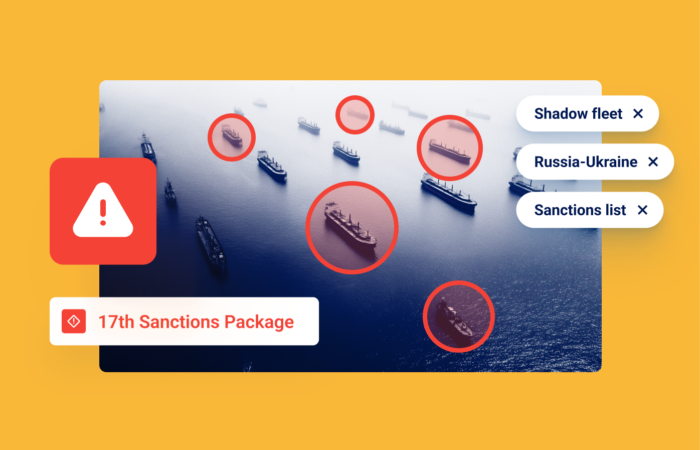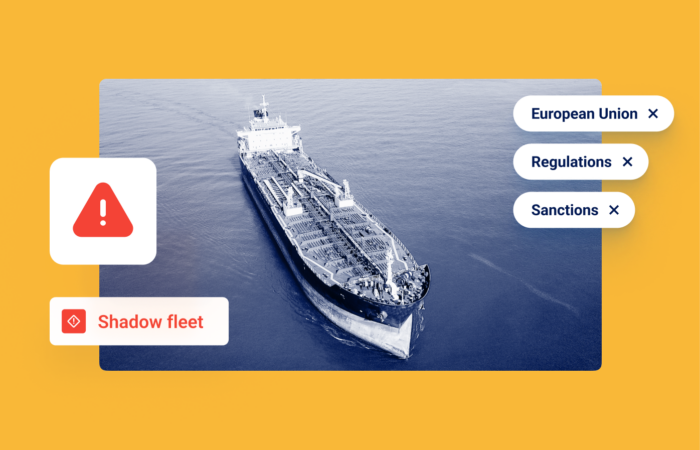The EU’s 15th Sanctions Package: Targeting Russia’s Shadow Fleet

What’s inside?
The European Union has introduced the 15th sanctions package, in its continued effort to address sanctions circumvention and undermine Russia’s military and industrial capabilities. It targets 52 additional ships involved in high-risk activities, including transporting oil, arms, and stolen Ukrainian grain.
Escalating Measures Against Russia’s Shadow Fleet
The EU’s focus in this sanctions package is clear: disrupt the operations of Russia’s “shadow fleet” – a network of vessels circumventing existing sanctions and facilitating Russia’s energy sector and war efforts. The Council of the EU emphasized that these measures aim to increase the cost of operating such fleets and restrict their access to European ports and services.
Insights from Windward’s Maritime AI™ platform reveal the following:
- Recurring violations:
- 63% of the identified vessels had been previously sanctioned, highlighting repeated non-compliance
- Risk levels:
- 23% of the vessels are classified as high-risk
- 14% are considered moderate-risk
- 38 vessels were flagged as risky between 2022-2024, following the start of the war in Ukraine
- Flag registrations:
- 46% of the vessels operate under a Barbados flag
- 23% operate under a Panama flag
- 10% operate under a Gabon flag, reflecting the strategic use of lenient regulatory environments
- Subclass breakdown:
- 65% of the vessels are crude oil tankers
- 13.5% are LNG tankers
- Beneficial owners’ locations:
- 40.4% are based in Russia
- 25% are based in the UAE
- 9.6% are based in China
These insights highlight the pervasive risk and strategic evasion tactics employed by the shadow fleet, reinforcing the importance of robust oversight and targeted sanctions.

The Unique Case of the Christophe de Margerie
Among the vessels targeted in this sanctions package is the Christophe de Margerie, a specialized Arctic tanker uniquely designed to navigate icy waters. This vessel has historically operated between Russia and China, facilitating the transport of LNG even under harsh winter conditions. Its inclusion in the sanctions list is particularly significant as winter begins, a season that traditionally heightens the demand for energy resources.
Insights from Windward’s Maritime AI™ platform show the vessel’s operational patterns – including 22 port calls in 2024 across long routes such as Zhoushan, China, Sabetta, and Bruges, Belgium – suggest a high level of efficiency and operational volume prior to its sanctioning.
While its recent activities show no overt signs of illicit behavior, the broader geopolitical implications are profound.
Implications of the 15th Sanctions Package
The sanctioning of the Christophe de Margerie is a pivotal development within this package. By targeting this vessel as winter approaches, the EU’s sanctions are expected to disrupt established LNG supply routes. This move could also heighten tensions between the EU and China, as the latter continues to rely on Russian commodities. The broader implications include potential shifts in global LNG trade patterns and further challenges to Russia’s Arctic strategy.
This comprehensive package demonstrates the EU’s commitment to leveraging its economic and regulatory power to counter Russia’s aggression in Ukraine. By targeting maritime logistics, critical industries, and key enablers of Russia’s war machine, the EU seeks to diminish Russia’s ability to sustain its military operations.
As the sanctions tighten, the global maritime community and associated industries are being drawn further into the broader geopolitical conflict. The expanded list of sanctioned vessels and organizations underscores the importance of due diligence and compliance to avoid unintended involvement in restricted activities.
A Commitment to Enforcement and Oversight
The EU’s sanctions also expand oversight on compliance with the G7’s oil price cap and crack down on evasive practices employed by the shadow fleet. The council has pledged to closely monitor shifts in trade and enforce stricter controls to maintain the effectiveness of these measures.
As explained by Maria Luís Albuquerque, Commissioner for Financial Services and the Savings and Investments Union, “Our sanctions have a clear objective – to weaken Russia’s economy and its ability to pursue its illegal aggression against Ukraine – and they are achieving that objective. With each new round of sanctions, we improve effectiveness and close gaps, and we will continue to do so, as part of our unwavering commitment to support Ukraine and its people.”
The EU’s steadfast dedication ensures that sanctions remain a powerful tool in supporting Ukraine and upholding international law.












